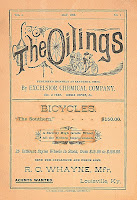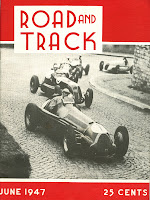The latest piece of the puzzle is The Californian. I could not hope to describe it any better than by pilfering Richard West's characteristically impeccable scholarship in the catalog description of Periodyssey, America's finest dealer in periodicals, from whom I acquired it.
A little bit about collecting here. You will note the catalog price of $7200. The present day economic woes (and, moreso, an ex-wife!) made that number somewhat prohibitive so, after giving him ample time to market the item, I negotiated a deal with Richard that included some cash and my six volumes of Harper's Weekly from 1860-1865. The details are not important but the philosophy is.
As a collector, rarity rules. I have only seen one other copy of The Californian for sale in thirty years and doubt I will see another. The other copy was at the California Book Fair about 15 years ago and, though I was tempted, it was so ridiculously overpriced that I passed on it. For all I know. this could be the same copy. So, despite my having only one Civil War run of the important Harper's Weekly, I know it could be easily replaced.
So win/win. Rich gets an item he can sell for a nice profit and I get an exceedingly important and rare item and free up some shelf space-Sort of like trading a superstar for a couple of prospects.
Ok. Enough pontificating. Now let's get to the good stuff.

The Californian (San Francisco) Vol. 1, No. 1 (May 28, 1864) to Vol. 2, No. 25 (May 20, 1865), comprising 51 issues (lacking the May 27 issue for a complete volume 2), bound in contemporary black half-leather and paper covered boards. Binding skillfully rebacked, handsome, edge wear and scuffing to boards; contents VG with light foxing. The Californian was the first important literary magazine produced west of the Mississippi. Charles Henry Webb, a former New York Times reporter, was its founder and editor. He chose as his assistant a young compositor on the San Francisco Golden Era, Bret Harte. Harte was to become the Californian's chief contributor (39 pieces in these two volumes) as well as editor for three months near the end of 1864. His exposure on the Californian put him in the position in 1868 to become editor of the newly launched Overland Monthly. But the Californian's most celebrated contributor was Mark Twain. While Twain had edited a few short-lived and minor Western newspapers before he walked into The Californian's offices, he was unknown to the literary world. The Californian became the first magazine (aside from one contribution to the Boston Carpetbag twelve years earlier) to publish his work. Bret Harte knew Twain was the real article; he placed most of his contributions on the front page. These two volumes contain twelve of Twain's emblematic essays:
-- October 1, 1864: A Notable Conundrum; First time magazine appearance of Clemen's work under the pseudonym "Mark Twain"; every bit as funny now as it was then. http://www.twainquotes.com/Calif/18641008.html -- October 8, 1864: Concerning the Answer to that Conundrum;-- October 15, 1864: Still further concerning that Conundrum;-- October 22, 1864: Whereas, or Loves Bakery;-- October 29, 1864: A Touching Story of George Washington's Boyhood;-- November 5, 1864: Daniel in the Lion's Den -- and Out Again All Right;-- November 12, 1864: The Killing of Julius Caesar -- Localized;-- November 19, 1864: A Full and Reliable Account of the Extraordinary Meteoric Shower;-- December 3, 1864: Lucretia Smith's Soldier;-- March 18, 1865: An Unbiased Criticism;-- May 6, 1865: The Important Correspondence of Mark Twain Concerning the Occupancy of Grace Cathedral; -- May 13, 1865: Further Correspondence of Mark Twain Concerning the Occupancy of Grace Cathedral.
In 1926, John Howell, the San Francisco bookseller, wrote "Very little is known of the work of Bret Harte and Mark Twain of the sixties, because the files of the publications for which they wrote have largely been destroyed." (Howell. Sketches of the Sixties [San Francisco, 1927]). OCLC isn't helpful because it combines this Californian (1864-1867) with the magazine of the same name that was published from 1880 to 1882, so it is difficult to figure out which institution has which title. The Union List is more straight-forward: it shows only four institutions holding complete volumes 1 and 2. This title is an important piece of Californiana and a cornerstone for any serious Twain collection. $7,200
Add this blockbuster to the next item and you have a real dynamic Twain duo.

Twain's first appearance was way back when he was sixteen, in Benjamin Shillaber's Carpet Bag in 1852, thirteen years prior to "The Notorious Jumping Frog of Calaveras County", considered to to be the work that launched his career (which appeared in The Saturday Press in November 1865 that, alas, I do not own). Schillaber's Mrs. Partington, who appeared in this journal, is considered to be the model for Tom Sawyer's Aunt Polly. Amazingly, some scholars disputed that it is Twain's work, but a short story set in Hannibal Missouri and signed S.L.C. leaves little doubt as to who wrote it. Heres a link it is in its entirety for your reading pleasure "The Dandy Frightening the Squatter", the first literary appearance of an American genious.
http://www.dandyism.net/?page_id=563
Twain's original work was published in magazines 178 times in a few dozen different publications, some posthumously. Most notably are the earliest excerpts of "Huckleberry Finn" in December, 1884 in The Century and "Tom Sawyer" in the exceedingly rare humor periodical Wild Oats on August 23rd, 1876 (the only known copy is at the New York Historical Society).

The first publication of "Huckleberry Finn"
One of my favorites is in the first issue of the very rare Kelley's Weekly on November 30, 1867. It contains a three column illustrated story entitled "A Yankee in the Orient. Mark Twain Takes a Turkish Bath." For you Twain scholars out there, my research indicates that this is the earliest appearance of any part of "Innocents Abroad" and that the six illustrations appear nowhere else!

Another favorite is this rare issue of Packard's Monthly that contains a Twain appearance.

The most comprehensive list of Twain Magazine appearances (not included is the Kelley's that I found later) is in a little volume Rich and I put together in 1997, what we lovingly refer to as "BALP", Bilbiography of American Literature in Periodicals available at http://www.periodyssey.com/
So there you have it- a marvelous asssociation with two of America's greatest assets- Mark Twain and its magazine heritage!
See you soon,
SL




















































